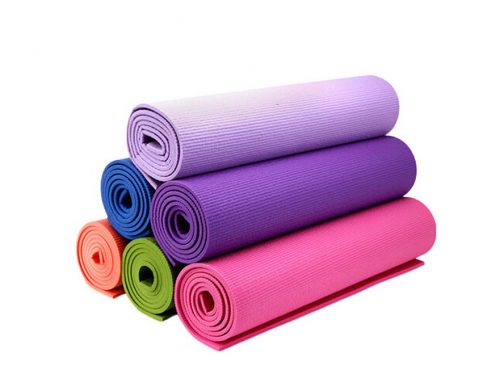Table of Contents
It is widely acknowledged that natural rubber yoga mats are expensive. However, many people know little about the reason why they are expensive. Today, we will present the production process of natural rubber yoga mats and the advantages of natural rubber yoga mats from a professional perspective:
The production process of natural rubber yoga mats is complex and has high technical content. The selection of raw materials, the machinery and equipment in the production process, the formula and the professionalism of the operators will all affect the final quality of the yoga mat.
I. The Basic Process Flow of Rubber
There are many types of rubber products, but the production process is basically the same. The basic process of rubber products using raw rubber, a general solid rubber, as raw materials includes six basic processes: plasticizing, mixing, rolling, extruding, molding, and vulcanization. Of course, basic processes such as raw material preparation, finished product finishing, inspection and packaging are also indispensable. The process of rubber processing is mainly to resolve the contradiction between plastic and elastic properties. Through various technological means, the elastic rubber becomes plasticized rubber, and then various ingredients are added to make semi-finished products. After that, the plastic semi-finished products are turned into rubber products with high elasticity and good physical and mechanical properties through vulcanization.
II. Raw Material Preparation
1. The main and basic raw material of rubber products is raw rubber which grows on tropical and subtropical rubber trees and is collected by manually cutting the bark.
2. The ingredient is an auxiliary material added to improve certain properties of rubber products.
3. Fiber materials (cotton, hemp, wool, various artificial fibers, synthetic fibers, metal materials and steel wires) are used as the framework material of rubber products to enhance mechanical strength and limit product deformation. In the raw material preparation process, the ingredients must be accurately weighed according to the formula. In order to make the raw rubber and the ingredients uniformly with each other, the material needs to be processed. The raw rubber should be dried in a drying room at 60-70°C before being cut and broken into small pieces. The block shaped ingredients such as paraffin, stearic acid and rosin must be crushed. If the powdered ingredients contain mechanical impurities or coarse particles, they need to be screened and removed. Liquid ones such as pine tar and coumarone need to be heated, melted, evaporated, and filtered. The ingredients must be dried, otherwise they would agglomerate easily. Bubbles will affect product quality if they cannot be dispersed uniformly during mixing.

III. Plasticizing
Raw rubber is elastic and lacks the necessary plasticity during processing, so it is not easy to process. Therefore, in order to improve its plasticity, it is necessary to plasticize the raw rubber so that the ingredients are easy to be evenly dispersed in the raw rubber during mixing, and the permeability and molding fluidity of the rubber in the process of rolling and molding can be improved. The degradation of long-chain molecules of raw rubber to form plasticity is called plasticization. There are two methods of plasticizing raw plastic, namely mechanical plasticization and thermal plasticization. Mechanical plasticization is adopted to shorten the degradation of long-chain rubber molecules by mechanical extrusion and friction of the plasticizer at a relatively low temperature, thereby shifting from the high elastic state to the plastic state. Thermoplastication is the process of obtaining plasticity where hot compressed air is injected into the raw rubber and the long-chain molecules are degraded and shortened under the action of heat and oxygen.
IV. Mixing
In order to adapt to the performance of yoga exercise and to improve the performance of natural rubber products, different ingredients must be added to the raw rubber. Mixing is a process in which the plasticized raw rubber is mixed with ingredients and placed in a rubber mixer to make the ingredients completely and uniformly dispersed in the raw rubber through mechanical mixing. Mixing is an important process in the production process of rubber products. If the mixing is not uniform, the role of rubber and compounding agents will not be fully played, which will further affect the performance of the product. The rubber material obtained after mixing is called the rubber compound. It is a semi-finished material for the manufacture of various rubber products, commonly known as the rubber compound, and is usually sold as a commodity. Buyers can use this rubber to directly process, shape and vulcanize to make the products that they need. With the unique formula of the Speck righting yoga mat, a semi-finished rubber product with strong grip and good elasticity can be mixed.
V. Molding
In the production process of rubber products, the process where a roller or extruder is used to pre-make various shapes and different sizes is called molding. The molding methods include:
1. Rolling
It is a method of pressing the rubber compounds into a film of a certain shape and a certain size through a roller. Some rubber products, such as tires, rubber cloth, hoses and other textile fiber materials must be coated with a thin layer of glue. The gluing process is generally completed on the roller. The fiber material needs to be dried and dipped before rolling. The purpose of drying is to reduce the water content of the fiber material, so as to prevent the water from evaporating and foaming and increase the temperature of the fiber material to ensure the quality of the rolling process. Glue dipping is a necessary process before gluing, and the purpose of it is to improve the bonding performance of fiber materials and rubber materials.
2. Extruding
It is a method in which a rubber compound with a certain degree of plasticity is put into the hopper of an extruder and passed through various mouth shapes under the extrusion of a screw. This method is also called a model of continuous molding. Before extruding, the rubber must be preheated to make the rubber soft and easy to extrude, so as to obtain rubber products with smooth surface and accurate size.
3. Molding
It is also practical to use the molding method to manufacture certain rubber products with complex shapes, such as cups and sealing rings. This method places the rubber material in the mold for heating with the help of the formed paired molds.
VI. Vulcanization
The process of transforming plastic rubber into elastic rubber is called vulcanization. A certain amount of vulcanizing agents is added to the semi-finished product made of raw rubber in the vulcanization tank. Under the specified temperature, the linear molecules of the raw rubber are heated and insulated to form a “sulfur bridge” to further create a cross-linked three-dimensional network structure, so that the plastic rubber becomes a high elastic vulcanizate. Since the crosslinking bond is mainly composed of sulfur, it is thereby called “sulfide”. Therefore, the process of transforming plastic rubber with linear structure into elastic rubber with three-dimensional network structure is called vulcanization. And any substance that can play a “bridging” role in rubber materials is called “vulcanizing agent” (the vulcanizing agent of Speck yoga mat is the agent adopted in the production process of high-end non-toxic cosmetics). The elastic rubber after vulcanization is called vulcanized rubber and soft rubber, commonly known as “rubber”. Vulcanization is one of the most important processes in rubber processing, and various rubber products must be vulcanized to obtain ideal performance. The unvulcanized rubber has no practical value in actual use. However, the insufficient vulcanization degree, inadequate vulcanization time to achieve the best state and overlong vulcanization time will all significantly degrade the rubber performance. Therefore, the vulcanization time must be strictly controlled in the production process to ensure that the vulcanized rubber products have the best performance and the longest service life.

natural rubber yoga mat
VII. Auxiliary Measures
Your Content Goes Here
Additional auxiliary measures should be added in production process in order to achieve better performance.
- Increasing strength
- Increasing wear resistance
- High air tightness requirements
- Increasing heat resistance
- Increasing cold resistance
- Increasing fire resistance
- Increasing oxygen and ozone resistance
- Improving electrical insulation
- Improving magnetism
- Improving water resistance
- Improving oil resistance
- Improving acid and alkali resistance +
- Improving high vacuum
The above is the production process of natural rubber. The following part focuses on its advantages. The first analysis is the barriers to the quality of a yoga mat:
- Raw material procurement: the source of ensuring product quality.
- Formula: The formula of yoga mats is of the utmost importance, which is why mats that look the same may differ in quality during use.
- Machinery: High technology not only brings efficiency but also produces superb craft in modern production.
- Accumulation of technical experience: Professionalism does not accomplish in an action, it takes time to accumulate.
- Factory scale: The scale determines the number of talents.
Advantages of Speck natural rubber yoga mat:
- Natural plant rubber that is environmentally friendly, easy to decompose and does not hurt yourself;
- Unique formula, unparalleled comfort and resilience;
- Extremely strong grip;
- Excellent seismic resistance;
- Unmatched anti-skid performance.
Speck is the top quality yoga mat manufacturer in China. You are welcome to contact us if any questions or inquiries.
Do You Want To Make Custom Design Yoga Mat?
Drop Us An Email And You Will Receive Our Feedback Within 24 Hours.
As a leading yoga mat manufacturer, Speck Group focuses on innovation, quality, simplicity, and sustainability.






